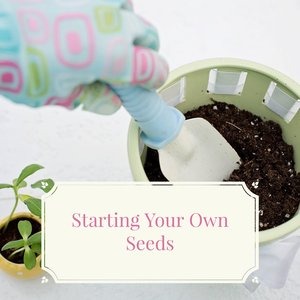The seeds of most annuals and vegetables are very easy to germinate. For the most part, all they require is a moist potting soil that maintains a temperature of seventy degrees. A regular potting soil is better to start seeds in than soil from your yard or garden, because it allows free development of the seedling’s roots, plus, there won’t be any weed seeds. Use fresh potting soil, as used soil has soil salts in it that can keep the seedlings from growing. Fill the containers you are going to use with potting soil and wet them down before you add the seeds. If the seeds are very tiny, like petunia or dianthus or alyssum, sprinkle the seeds over the top of the soil and press them in gently, but don’t cover them. The exposure to light helps them to germinate more quickly. If the seeds are larger, like marigolds or nasturtiums, you can cover them with a very thin layer of potting soil. It is very difficult to keep the seeds from drying out, so one hint is to cover the tray with plastic wrap and keep it out of direct sunlight. Another trick to keep the seeds the right temperature is to put the tray on top of the refrigerator while they germinate. They will stay nice and warm there. Watch the seeds closely- if they seem to be drying out, mist them with a spray bottle. As soon as they begin to sprout, remove the plastic wrap and put them where they will get sunlight, but don’t forget to keep them moist. If the sunlight is coming from only one direction, you will probably end up with lanky, tall seedlings that won’t transplant well. You can even out the light by making a reflector from cardboard covered with aluminum foil and propping it against the side that receives the least light. When the seedlings have at least three or four true leaves, not counting the two they came up with, transplant the seedlings into individual pots. When all danger of frost has passed, you can set the plants out into your flower beds or garden, but be sure to harden them off for a few days first so they don‘t shock. Harden them off by putting them outside in the shade during the day and bringing them in at night.
















